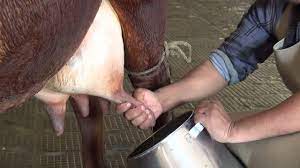The milk process also known as the methods of milking requires several important steps, and the purpose of these steps is to elicit optimal milk letdown, minimize the chances of a cow contacting mastitis organisms during milking, and efficient milk removal.
Milking animals refers to the process of extracting milk from dairy animals, such as cows, goats, sheep, and buffaloes. This practice is primarily performed for human consumption and dairy product production, including milk, cheese, butter, yogurt, and other dairy items.
Methods of Milking Animals

A. Hand Milking
Cows are milked from left side. after let down of milk, the milker starts milking teats either cross wise or fore quarters together and then hind quarters together or teats appearing most distended milked first few streams of fore milk from each teat be let on to a strip cup. This removes any dirt from the teat canal and gives the operator a chance to detect mastitis.
Milking is done either by stripping or by full hand method. Stripping is done by firmly holding the teat between the thumb and fore finger and drawing it down the length of the teat and at the same time pressing it to cause the milk to flow down in a stream. Grasping the teat with all the five fingers and pressing it against
Read Also: Properties of Milk, Processing Methods, Packaging and Distribution
B. Machine Milking
Modern milking machines are capable of milking cows quickly and efficiently, without injuring the udder, if they are properly installed, maintained in excellent operating conditions, and used properly. The milking machine performs two basic functions.
It opens the streak canal through the use of a partial vacuum, allowing the milk to flow out of the teat cistern through a line to a receiving container. It massages the teat, which prevents congestion of blood and lymph in the teat.
Advantages
The advantages of this milking machine are manifold.
• It is easy to operate, costs little, and saves time as it milks 1.5 litre to 2 litres per minute.
• It is also very hygienic and energy-conserving as electricity is not required.
• All the milk from the udder can be removed.
• The machine is also easily adaptable and gives a suckling feeling to the cow and avoids pain in the udder as well as leakage of milk.
Read Also: The Coconut Milk: Economic Importance, Uses, and By-Products
Read Also: Understanding the Cost of Waste Recycling
